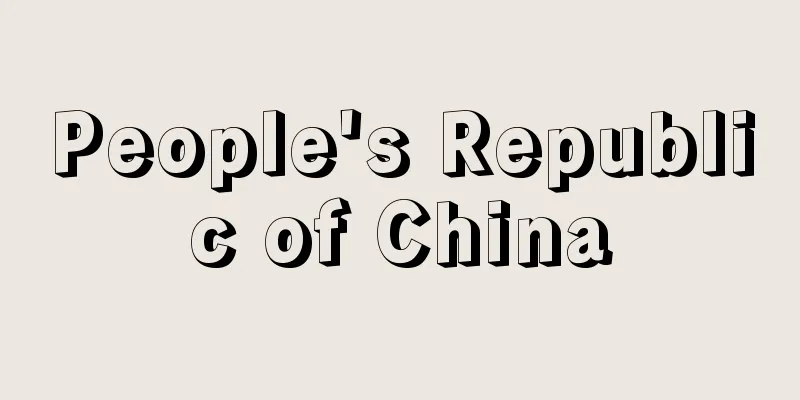People's Republic of China

|
◎Official name: People's Republic of China. ◎Area: 9,572,900 km2 (including Taiwan). ◎Population: 1,339,720,000 (2010). ◎Capital: Beijing (12,290,000, 2013). ◎Residents: 92% Han Chinese, plus 55 minority groups such as Zhuang, Uighur, Yi, Tibetan, and Miao. ◎Religion: Religious activities are restricted, with 1% being Muslim, and a small number of Christians and Lamaists. ◎Languages: Mostly Chinese (northern languages, Wu dialect, Hakka, etc.). The common language is Mandarin, based on Beijing dialect. Other minority languages. ◎Currency: Yuan, Hong Kong Dollar. ◎Head of state: President, Xi Jinping (elected March 2013. Five-year term. Became General Secretary of the Communist Party in November 2012). ◎Prime Minister: Li Keqiang (elected March 2013. Five-year term). ◎Constitution: Effective December 1982. ◎Parliament: Unicameral National People's Congress (consisting of representatives elected by provinces, directly controlled municipalities, autonomous regions and the People's Liberation Army. The 11th term ended in March 2011 with 2,979 representatives, five-year term). ◎GDP: $7,916.4 billion (2008, excluding Taiwan, same below). ◎GDP per capita: $5,962 (2008). ◎Proportion of workers employed in agriculture, forestry and fishing: 64.9% (2003). ◎Average life expectancy: 72.4 years for men, 77.4 years for women (2010). ◎Infant mortality rate: 16‰ (2010). ◎Literacy rate: 94.0% (2009). * *Abbreviation: China. The People's Republic was established on the Chinese mainland on October 1, 1949. [Nature and people] Located in the southeastern part of the Eurasian continent, facing the Pacific Ocean. It borders the Democratic People's Republic of Korea, Russia, Mongolia, Kazakhstan, Kyrgyzstan, Tajikistan, Afghanistan, Pakistan, India, Nepal, Bhutan, Myanmar, Laos, and Vietnam, and is separated by the sea by Korea, Japan, and the Philippines. More than 90% of the population is Han Chinese, with 55 other ethnic minorities including Mongolians, Tibetans, Turkic peoples (Hui and others), Uighurs, Zhuangs, Miaos, and Yaos. Administratively, it is divided into four directly controlled municipalities (Beijing, Shanghai, Tianjin, and Chongqing), 23 provinces, and five autonomous regions (Inner Mongolia Autonomous Region, Ningxia Hui Autonomous Region, Xinjiang Uighur Autonomous Region, Guangxi Zhuang Autonomous Region, and Tibet Autonomous Region). As a multi-ethnic nation, it has placed importance on ethnic policy since its founding and adopted regional autonomy for ethnic groups, and in addition to the five autonomous regions, it has established autonomous prefectures and autonomous counties depending on the level of concentration of ethnic minorities. In order to determine whether an ethnic group could exercise autonomy, the State Ethnic Affairs Commission began an "ethnic identification operation" in 1950, and by 1979 had recognized the 55 ethnic minorities listed above. [Nature] The natural environment is diverse due to its vast area and complex topography, but it can be divided into three major areas: 1. Tibet-Yunnan-Guizhou Plateau, 2. Xinjiang-Mongolian Plateau, and 3. Mainland China and the Northeast Plain. The Tibetan Plateau is the world's largest plateau, and is the source of many great rivers, including the Yellow River, the Yangtze River, the Mekong River, the Menam River, the Ganges River, and the Indus River. The Xinjiang-Mongolian Plateau is arid, mountainous, desert, and grassland region, with few cultivated areas and little rainfall, and both regions are sluggish in industry. Mainland China is divided into North China, Central China, and South China, with high west and low east, by the Qinling Mountains running east to west and the Xingan Mountains running north to south. North China has little precipitation, a continental climate, and extensive loess soil areas, and is primarily cultivated as field crops such as soybeans, wheat, and cotton. Central and southern China has a lot of precipitation, a warm and humid climate, while the southern region has a subtropical to tropical climate, where rice is the main source of paddy field agriculture, and produces tea, tung oil, and fruit. There are also areas where rice is grown twice a year. In general, there are significant differences in culture, language, constitution, village organization, and customs between North China and Central and Southern China. Northeast has a somewhat independent natural environment, little precipitation, and is one of the coldest regions in China. In terms of transportation, the Northeast has the most developed railway network, followed by North China and Central China. Tibet, the northwest, and southwest are underdeveloped, and since liberation, development of automobile roads has been progressing. Maritime transport is centered around ports such as Dalian, Qinhuangdao, Qingdao, Lianyungang, Shanghai, Fuzhou, Tianjin, Xiamen, Shantou, Guangzhou, and Zhanjiang, while inland water transport is well developed along the Yangtze and Pearl Rivers. [Industry] After liberation, construction routes changed through the first Five-Year Plan (1953-1957), the second (1958-1960), the planned adjustment period (1961-1965), the third (1966-1970), and the ninth (1996-2000). In agriculture and forestry, production increased due to nationwide land reform, large-scale flood control works, and reforestation. In livestock farming, progress was made in improving breeds and preventing disease. The mining industry has improved significantly in iron, coal, gold, and oil in the north, and tin, mercury, tungsten, and other special metals in the south. Modern industry was previously limited to the southern part of the northeast, Shanghai, and Wuhan, but in recent years it has spread widely to inland areas. Furthermore, development has been remarkable in coastal areas such as Guangdong Province, and the promotion of reform and opening-up policies since the late 1970s and the establishment of special economic zones and coastal open cities have fundamentally changed the foundations of the Chinese economy. In addition, in rural areas, a production contract system was introduced in 1980, and each farm household was given land, and the family unit shifted to farming (people's communes were dissolved by 1985). To absorb the surplus population in rural areas, township and village enterprises were established as township and village-run, individually managed businesses. [History] Paleolithic artifacts have been discovered in Ordos, Dingcun, Shanxi Province, and other places, including the bones of Sinanthropus pekinensis in Zhoukoudian. In the Neolithic period, the Han people, who were settled agriculturalists, formed settlements and cultivated the painted pottery and black pottery cultures. From the Yin to Zhou dynasties, a unique bronze culture developed and the prototype of the feudal system was established. In the 8th century BC, in the latter half of the Zhou dynasty, feudal lords competed for supremacy in the Central Plains, and industry, thought, and learning developed, giving rise to the Hundred Schools of Thought. In 221 BC, the Qin Dynasty founded the first unified dynasty, and forced through a rapid policy of control under a centralized system of prefectures and counties, but failed and was replaced by the Han Dynasty. Over the course of the 400-plus years of the Qin and Han dynasties, a bureaucratic organization with an emperor at the top, which would remain consistent throughout Chinese history, was standardized, various cultural artifacts unique to China were largely established, and Confucianism became the state religion. The Han people also developed south across the Yangtze River and advanced further westward, promoting the sinicization of the indigenous ethnic groups and expanding the Chinese cultural sphere. Towards the end of the Han dynasty, many warlords fought for power, and after the Three Kingdoms period, the country split up. Foreign tribes invaded the north, giving rise to the Five Barbarians and Sixteen Kingdoms period, but it gradually became more Sinicized, and conflict between the Northern and Southern Dynasties arose (see Wei, Jin, and the Northern and Southern Dynasties period). During this time, the spread of Buddhism, an imported religion, had a major impact on thought and the arts and sciences, including the establishment of Taoism. In 589, the Sui dynasty unified the country, and in 618, the Tang dynasty succeeded it, becoming the world's strongest and greatest civilized nation. Communication with the West led to the flourishing of a culture of world-historical proportions, promoting self-awareness among the surrounding ethnic groups, and heralding a major turning point in East Asian culture. After more than 50 years of turmoil and division during the Five Dynasties and Ten Kingdoms period, the Song dynasty unified China, but its civilian-ruled policies brought foreign aggression, and the policies of Shenzong and Wang Anshi to enrich the country and strengthen its military also failed. The Song dynasty was forced to make concessions to the Liao and Western Xia dynasties, and then submitted to the Jin dynasty. It lost the northern half of China and moved south in 1127. In the early 13th century, the Mongols rose up in the north and established the unprecedented Mongol Empire, conquering and ruling all of China, overpowering the Han people and calling itself the Yuan dynasty. About 100 years later, Zhu Yuanzhang founded the Ming dynasty in 1368, established the dictatorial power of the monarchy, and restored Chinese civilization. Europeans also came to China toward the end of the Ming dynasty, but the Ming was destroyed by the Jurchen clan that rose up in the northeast, and the Qing dynasty was established. [From the Qing to the Republic of China and the People's Republic of China] The early Qing dynasty, under the three reigns of Emperors Kangxi to Qianlong, lasted for over 130 years and was an unprecedented period of prosperity and strength. However, at the end of the Qing dynasty, imperialist invasions from various countries destroyed the idea of Chinese sovereignty, Russia invaded from the north and west, and after the Opium Wars of 1840-1842, China suffered successive defeats in the Arrow War, the Sino-French War, and the Sino-Japanese War, resulting in a semi-colony. However, the national revolutionary fervor under the banner of "Destroy Manchuria and Rebuild the Han" intensified, and the Republic of China was established in 1912 under the leadership of Sun Yat-sen through the Xinhai Revolution. Meanwhile, the struggle for power continued between the former warlords and bureaucrats, and the revolution was promoted in the first Kuomintang-Communist cooperation from 1924 to 1927, but after the completion of the Northern Expedition in 1928, the Kuomintang's dictatorial Nationalist Government took control and oppressed the Chinese Communist Party. Due to the intensification of anti-Japanese movements and Japan's hard-line policy against China, the Manchurian Incident and the Sino-Japanese War broke out. This led to the formation of the second Kuomintang-Communist cooperation and the Anti-Japanese National United Front, and continued the war against Japan with the support of the United States and the Soviet Union. After World War II, the Kuomintang-Communist struggle intensified again, and the People's Liberation Army of the Chinese Communist Party ultimately won. Meanwhile, the Nationalist government lost its mainland and fled to Taiwan, where it maintained power with the support of the United States, but in recent years it has experienced remarkable economic growth and has been promoting exchanges with the mainland since the late 1980s. [After the establishment of the People's Republic of China] After winning the civil war, the Chinese Communist Party proposed the Chinese People's Political Consultative Conference, which united democratic forces in 1948, and decided on a common platform at the first plenary session in September 1949. The new state was defined as a new democratic state, and on October 1 of the same year, the People's Republic of China was established with Mao Zedong as head of state. Furthermore, in 1954, the Constitution was established. The highest organ is the National People's Congress, with the President as the head of state, the State Council as the executive branch, the Supreme People's Court as the judicial branch, and the Supreme People's Procuratorate as the prosecutor. After 1950, the country eliminated feudal corruption, and implemented various reforms in the economic, social, and cultural fields, focusing on completing land reform (see China Land Reform Law), rationally adjusting industry and commerce, and reducing state expenses. As a result, the country was able to quickly put an end to the chaos that followed the revolution, and in 1950 it also promoted diplomacy with other countries, such as the signing of the Sino-Soviet Treaty of Friendship, Alliance, and Mutual Assistance. After overcoming the hardships of the Korean War, the country entered the stage of long-term construction in the political and economic fields, with the first Five-Year Plan in 1953 and the election of the People's Congress. On the other hand, despite major problems both at home and abroad, such as three consecutive years of natural disasters from 1959 and the Sino-Soviet dispute since July 1960, the country expanded the people's communes, which were considered a transition from socialism to communism. China also demonstrated its military strength by conducting its first atomic bomb test on October 16, 1964, and increased its international presence. The Cultural Revolution, which began in 1965, brought chaos to many areas for 10 years, but during that time China joined the United Nations, the US-China summit was held, diplomatic relations with West Germany and Japan were re-established, and the Fourth Five-Year Plan was also launched. In the 1970s, the leadership of Mao Zedong and Zhou Enlai weakened, and the Gang of Four, consisting of Jiang Qing, Zhang Chunqiao, Yao Wenyuan, and Wang Hongwen, rose to power and promoted a far-left line, causing great economic turmoil. After the deaths of Zhou Enlai and Mao Zedong, the Gang of Four was overthrown in 1976, and the Hua Guofeng administration was established. This administration declared the end of the First Cultural Revolution in 1977. Furthermore, the government embarked on the "four modernizations" of agriculture, industry, defense, and science and technology, and changed from the previous line to one of economic construction and productive development. Externally, China sought to approach the West, but its relations with the Soviet Union deepened with the abolition of the Sino-Soviet Treaty of Friendship, Alliance and Mutual Assistance (the relationship was reconciled at a summit in 1989). [The era of reform and opening-up policies, economic growth, and becoming a superpower] Criticism of the Mao Zedong system intensified in the late 1970s, and Zhao Ziyang was appointed Premier in September 1980, replacing Hua Guofeng, and Hu Yaobang was appointed Chairman in June 1981. In September 1982, the Chairman system was abolished, and Hu Yaobang was appointed General Secretary of the Party with the support of Deng Xiaoping, but he was dismissed by conservatives in January 1987, and his successor, Zhao Ziyang, was also dismissed after being criticized by conservatives for his response to the student and citizen democratization movement (Tiananmen Square incident) that spread throughout China in June 1989, centered on Tiananmen Square in Beijing. Jiang Zemin, who succeeded Deng as General Secretary of the Communist Party with the backing of Deng, subsequently served as Chairman of the Central Military Commission of the Party and the State, and was elected President in 1993, solidifying the foundations of his administration. During this time, as the socialist systems of Eastern Europe and the Soviet Union collapsed from the late 1980s to the early 1990s, China made the construction of a socialist market economy its top priority under its reform and opening-up policies, achieving an average real GDP growth rate of over 9% per year for over 20 years, and in 2010 it overtook Japan in terms of GDP size to become the world's second largest economy. On the other hand, however, there are many issues to be addressed, such as how to respond to various social problems accompanying the widening economic disparity between urban and rural areas (for example, the sharp increase in migrant workers, known as "blind drift" or "mingong tide"), environmental issues, trends in the ethnic autonomous regions (the desire for independence in Tibet, Xinjiang Uyghur, etc.), relations with Taiwan, and how to realize "one country, two systems" in Hong Kong, which was returned to China in July 1997, and Macau, which was returned to China in December 1999. At the 10th National People's Congress held in March 2003, Hu Jintao (who became General Secretary of the Party in November 2002) and Wen Jiabao were elected to succeed President Jiang Zemin and Premier Zhu Rongji, respectively. In September 2004, Jiang Zemin resigned as Chairman of the Central Military Commission, and Hu Jintao, Vice Chairman of the Central Military Commission, was promoted (Xu Caihou was the successor to Vice Chairman of the Central Military Commission). In 2008, President Hu Jintao and Premier Wen Jiabao were reappointed, and domestically, they made clear their intention to tackle the distortions of rapid economic growth under the slogan of a harmonious society. In the same year, the Beijing Olympics were successfully held. However, during the preparations for the Olympics, protests against the human rights oppression of the Tibetan people and other issues were launched around the world. In July 2009, a large-scale clash occurred between the Uighurs and the Han Chinese in Urumqi, Xinjiang Uighur Autonomous Region. Hu Jintao was forced to return home suddenly from the summit held in L'Aquila, Italy, and domestic problems including ethnic minority issues and human rights issues are piling up. Furthermore, internationally, China, which has become the center of the world economy, is required to take new measures on global issues such as measures against global warming. In December 2001, China joined the World Trade Organization (WTO) together with Taiwan. In terms of relations with Japan, in 2006, Japan's trade with China surpassed that with the United States, making China Japan's largest trading partner. Meanwhile, summit diplomacy was suspended for more than five years due to Prime Minister Koizumi's visit to Yasukuni Shrine, political exchanges cooled, and a state of "cold politics, hot economics" continued. However, summit diplomacy was revived in 2006, and the two countries agreed to make efforts to build a "strategic mutually beneficial relationship." The Democratic Party government that came to power in September 2009 adopted a diplomatic stance that placed emphasis on East Asia, and political exchanges between Japan and China have achieved a certain degree of stability. The Hu Jintao administration successfully hosted the Shanghai World Expo in 2010, and, with the world's second largest economy as a backdrop, has begun to support EU countries suffering from a financial crisis. However, at the same time, China has strengthened its military presence in neighboring countries by asserting its military buildup and core national interests, creating tensions with Japan over the Senkaku Islands issue, and with the Philippines and Vietnam over the Spratly Islands. At the Communist Party Congress in November 2012, Hu Jintao handed over his positions as General Secretary and Chairman of the Central Military Commission to Xi Jinping, who was elected President at the National People's Congress in March 2013, completing the power transfer process. Li Keqiang succeeded Wen Jiabao as Prime Minister. The harmonious society advocated by the Hu Jintao regime is far from being realized, as symbolized by the large-scale air pollution that occurred in major cities in the winter of 2013. It can even be said that corruption and wrongdoing surrounding vested interests are part of the system's internal structure, as shown by the Bo Xilai and Zhou Yongkang scandals that shook the regime itself. Censorship of speech has also been further strengthened, as seen in the Nobel Peace Prize controversy of 2010. With China's economic growth slowing to the 7% range, in 2014 the Xi Jinping leadership, backed by its abundant financial resources, proposed the establishment of an Asian Infrastructure Investment Bank (AIIB) in order to promote investment in Asia, where economic development is expected. → Related topics Shanghai World Expo | National People's Congress | China | Chinese Nationalist Government | Pu Jie | BRICs | Beijing Olympics (2008) Source : Heibonsha Encyclopedia About MyPedia Information |
|
◎正式名称−中華人民共和国People's Republic of China。◎面積−957万2900km2(台湾を含む)。◎人口−13億3972万人(2010)。◎首都−北京Beijing(1229万人,2013)。◎住民−漢民族92%のほか,チワン族,ウイグル族,イ族,チベット族,ミヤオ(苗)族など55の少数民族。◎宗教−宗教活動は制限されており,イスラム1%,キリスト教,ラマ教などが少数。◎言語−漢語(北方語,呉語,客家(ハッカ)語など)が大部分。共通語は北京語を基礎とした〈普通話〉。その他少数民族の言語。◎通貨−元Yuan,香港ドルHong Kong Dollar。◎元首−国家主席,習近平(2013年3月選出。任期5年。2012年11月共産党総書記就任)。◎首相−李克強(2013年3月選出。任期5年)。◎憲法−1982年12月発効。◎国会−一院制の全国人民代表大会(省,直轄市,自治区および人民解放軍選出の代表よりなる。2011年3月第11期の代表は2979名,任期5年)。◎GDP−7兆9164億ドル(2008,台湾を除く,以下同じ)。◎1人当りGDP−5962ドル(2008)。◎農林・漁業就業者比率−64.9%(2003)。◎平均寿命−男72.4歳,女77.4歳(2010)。◎乳児死亡率−16‰(2010)。◎識字率−94.0%(2009)。 * *略称は中国。1949年10月1日中国本土に成立した人民共和国。〔自然・住民〕 ユーラシア大陸の南東部に位置し,太平洋に臨む。朝鮮民主主義人民共和国,ロシア,モンゴル,カザフスタン,キルギス,タジキスタン,アフガニスタン,パキスタン,インド,ネパール,ブータン,ミャンマー,ラオス,ベトナムに接し,海を隔てて韓国,日本,フィリピンに対している。90%以上が漢民族,他にモンゴル族,チベット族,トルコ系諸族(回族その他),ウイグル族,チワン族,ミヤオ族,ヤオ族など55種の少数民族を含む。行政上は4直轄市(北京,上海,天津,重慶),23省,5自治区(内モンゴル自治区,寧夏回族自治区,新疆ウイグル自治区,広西チワン族自治区,チベット自治区)に分轄。多民族国家として建国前後から民族政策を重視して民族区域自治を採り,5自治区のほかに少数民族の集住するレベルに応じて自治州,自治県などを置いている。自治権を行使しうる民族集団か否かを確認するために,1950年から国家民族事務委員会が〈民族識別工作〉を実施し,1979年までに上記55の少数民族を認定した。〔自然〕 自然環境は面積広大で地勢が複雑なため多様にわたるが,1.チベット〜雲貴高原,2.新疆・モンゴル高原,3.中国本土と東北地区平原に3大別できる。チベット高原は世界第1の高原で,黄河,長江(揚子江)をはじめ,メコン,メナム,ガンジス(ガンガー),インダスなど諸大河の源流地域である。新疆・モンゴル高原は乾燥した山岳と砂漠,草原地帯で,耕作地帯に乏しく,降水量は少なく,ともに産業は不振である。中国本土は東西に走る秦嶺山脈の線と南北に走る興安嶺山脈の線により,西高東低で,華北・華中・華南に分かれる。華北は降水量少なく,大陸性気候で黄土(レス)層地帯が広がり,ダイズ,小麦,綿花などの畑作が中心である。華中・華南は降水量多く,温暖湿潤で,南部では亜熱帯・熱帯性気候を呈し,稲作中心の水田農業が主で,茶,桐油,果物などを産する。また水稲二期作地帯もある。一般に華北と華中・華南では文化,言語,体質,集落組織,風俗などに顕著な差がみられる。東北はやや独立的自然環境をもち,降水量少なく,中国最寒区の一つ。交通は東北地区に最も発達した鉄道網をもち,華北・華中がこれに次ぐ。チベット,北西部,南西部の地区は未発達で,解放後,自動車道路の開発が進められている。海運は大連,秦皇島,青島(チンタオ),連雲港,上海,福州,天津,アモイ(厦門),汕頭(スワトウ),広州,湛江等の各港を中心に行われ,内陸水運は長江と珠江がよく発達する。〔産業〕 解放後,第1次五ヵ年計画(1953年―1957年),第2次(1958年―1960年),計画調整期(1961年―1965年),第3次(1966年―1970年),そして第9次(1996年―2000年)まで建設路線の変遷をみた。農林業では全国的土地改革,大治水工事,植林などで生産が増大した。牧畜は品種改良,疫病防除が進んだ。鉱工業は北部の鉄・石炭・金・石油,南部のスズ・水銀・タングステンその他の特殊金属で大きく生産が向上した。近代工業は従来,東北地区南部,上海,武漢などに限定されていたが,近年は内陸地帯にも広く分布。さらには広東省などの沿海部での発達が著しく,とりわけ1970年代末からの改革・開放政策の推進と,これに伴う〈経済特区〉や〈沿岸開放都市〉などの設置が中国経済の基幹を根本的に変えた。また農村では1980年から〈生産請負制〉が導入され,農家1戸ごとに支給された土地で,家族単位で農業に従事する方式に移行(人民公社は1985年までに解体)。農村の余剰人口を吸収するために〈郷鎮企業〉が町村営・個人経営で設立された。〔歴史〕 周口店におけるシナントロプス・ペキネンシスの人骨をはじめ,オルドス,山西省丁村などから旧石器時代の遺物が発見されている。新石器時代には定住農耕民である漢族が集落を形成し,彩陶・黒陶文化を育成した。殷(いん)〜周代には独特の青銅器文化が発達し,封建制度の原型が確立した。前8世紀,周代の後半には諸侯は中原に覇を争い,産業・思想・学術が発達し,諸子百家が生まれた。前221年秦が最初の統一王朝を創建し,中央集権,郡県制下に急激な統制政策を強行したが失敗,漢がこれに代わった。秦漢400余年の間に,以後中国史を一貫する帝王を頂点とする官僚組織が定型化され,中国独自の各種文物がほぼ確立し,儒教は国教の位置を占めた。また漢族は長江を越えて南に発展し,さらに西方へも進出して,先住異民族の中国化を促進,中国文化圏を拡大した。漢末には群雄割拠し,三国鼎立(ていりつ)(三国時代)を経て分裂し,北部には異民族が入って五胡十六国時代を現出したが,次第に中国化し,さらに南北朝の対立となった(〈魏晋南北朝時代〉参照)。この間,外来宗教である仏教の弘通(ぐつう)で,道教の成立をみるなど思想・学芸上に大きな影響があった。 589年隋が天下を統一,618年唐がこれを継承し,世界最強最大の文明国となった。西方との交通により世界史的規模の文化が繁栄し,周辺諸民族の自覚を促進,東アジア文化に一大転換期を迎えた。五代十国50余年の紛乱と分裂の後,宋が統一したが,その文治主義政策は外患を招き,神宗と王安石の富国強兵策も失敗し,遼・西夏に譲歩を余儀なくされ,金に屈服し,中国の北半を失って1127年南方に移った。13世紀初頭モンゴルが北方に興起し,史上空前のモンゴル帝国を建設,中国全土を征服支配し,漢族を圧倒して元と称した。約100年後,朱元璋は1368年明を創建し,君主独裁権を確立して,中国文明を復興した。明代末ごろヨーロッパ人の来通もあったが,東北地区に興起した女真の一族によって明は滅ぼされ,清が建てられた。〔清から中華民国,中華人民共和国へ〕 清朝初期の康煕(こうき)帝〜乾隆帝3代130余年は史上未曾有の富強時代となったが,清朝末期には諸外国の帝国主義的侵略が,中華独尊思想を破砕し,ロシアは北・西辺より侵入,1840年―1842年のアヘン戦争以後,アロー戦争,清仏戦争,日清戦争等の連続した敗戦で半植民地に転落した。しかし,〈滅満興漢〉を旗印とした民族革命熱が激化し,辛亥(しんがい)革命によって1912年孫文が指導した中華民国が成立した。一方旧軍閥・官僚の政権争奪は続き,1924年―1927年の第1次国共合作で革命を推進したが,1928年北伐完成後,中国国民党独裁の中国国民政府が支配し,中国共産党を弾圧した。排日運動の激化と日本の対中国強硬策のため満州事変,続いて日華事変(日中戦争)が勃発(ぼっぱつ),これを機に第2次国共合作と抗日民族統一戦線を結成し,米ソの援助によって抗日戦争を継続した。第2次大戦後,国共の抗争は再び激化し,終局的には中国共産党の人民解放軍が勝利を収めた。一方,中国国民政府は本土を失って台湾にのがれ,米国の援助のもとに政権を保持してきたが,近年は経済成長が著しく,1980年代末からは大陸との交流を推進している。〔中華人民共和国成立以後〕 国内戦に勝利した中国共産党は,1948年民主勢力を糾合した中国人民政治協商会議を提唱,1949年9月第1回全体会議で共同綱領を決定した。新国家の性格を新民主主義国家と規定し,同年10月1日,毛沢東を元首として中華人民共和国が成立した。さらに,1954年に憲法を制定した。最高機関は全国人民代表大会で,元首は国家主席,行政は国務院,司法は最高人民法院,検察は最高人民検察署がつかさどる。1950年以後,土地改革の完成(〈中国土地改革法〉参照),工業・商業の合理的調整,国家経費の節減を中心に封建的腐敗を排除して,経済・社会・文化の各方面で諸種の改革を断行した。これにより革命後の混乱を急速に収拾し,1950年には中ソ友好同盟相互援助条約締結をはじめ諸外国との外交も促進した。朝鮮戦争の苦難を越え,1953年第1次五ヵ年計画,人民代表大会の選出など政治・経済の面で長期建設実践の段階に入った。一方,1959年から3年連続の自然災害,1960年7月以来の中ソ論争など,内外に大問題をかかえつつも,社会主義から共産主義への移行とされる人民公社を拡大させた。また1964年10月16日には最初の原爆実験を行うなど,軍事面での強化を示し,国際的にもその比重を増した。1965年から始まった文化大革命は,10年にわたって各方面に混乱をもたらしたが,その間に中国の国連参加,米中首脳会談開催,西ドイツ,日本との国交再開などが行われ,第4次五ヵ年計画も開始された。 1970年代の中国は,毛沢東,周恩来の指導体制が弱体化するなかで江青,張春橋,姚文元,王洪文の〈四人組〉が台頭し,極左路線を推進したため,経済は大きく混乱した。周恩来,毛沢東の死後の1976年に四人組を打倒して華国鋒政権が成立。同政権は1977年に第1次文化大革命の終結を宣言。さらに農業,工業,国防,科学技術の〈四つの現代化〉に着手し,従来の路線から経済建設・生産力発展路線に転換した。対外的には西側への接近を図ったが,対ソ関係は中ソ友好同盟相互援助条約を廃棄するなど,対立を深めた(1989年首脳会談で和解)。〔改革・開放政策と経済成長,超大国化の時代〕 1970年代末には毛沢東遺制への批判が強まり,華国鋒に代わって1980年9月首相に趙紫陽,1981年6月主席に胡耀邦が就任した。1982年9月主席制度を廃止し,【とう】小平の支持の下に胡耀邦が党総書記に就任したが,1987年1月党内保守派により解任され,後任の趙紫陽も,1989年6月北京の天安門広場を中心として中国全土に広がった学生・市民の民主化運動(天安門事件)への対応を保守派から批判され解任された。【とう】小平のあと押しで後任の党総書記に就任した江沢民は,その後,党および国家の中央軍事委主席につき,1993年国家主席にも選ばれて政権の基盤を固めた。 この間,1980年代末から1990年代初めにかけて東欧・ソ連の社会主義体制が崩壊するなかで,中国は改革・開放政策のもとで社会主義市場経済の建設を至上命題としつつ,20年以上にわたり年平均9%以上の実質GDP成長率を達成し,2010年にはGDP規模で日本を追い抜き世界第2位の経済大国となった。しかし,他方では,都市と農村の経済格差の拡大に伴う各種の社会的問題への対応(例えば〈盲流〉〈民工潮〉などと呼ばれる出稼ぎ農民の激増),環境問題,民族自治区における動向(チベット,新疆ウイグルなどの自立への志向),台湾との関係,1997年7月に返還された香港,1999年12月に返還されたマカオで〈一国二制度〉をどのように実現するのか等,課題は多様である。2003年3月に開かれた第10期全国人民代表大会で,江沢民国家主席と朱鎔基首相の後任に胡錦濤(2002年11月党総書記に就任),温家宝がそれぞれ選出された。2004年9月,江沢民が党中央軍事委主席を辞任,同委副主席の胡錦濤が昇格した(同委副主席の後任は徐才厚)。2008年胡錦濤国家主席,温家宝首相が再任され,国内的には和諧社会をスローガンに高度経済成長のひずみ是正に取り組む姿勢を明らかにした。また同年北京オリンピック開催を成功させた。しかし,オリンピック開催準備中にチベット族への人権抑圧などに抗議する運動が世界中で展開された。また2009年7月には,新疆ウイグル自治区のウルムチで,ウイグル族と漢族の大規模な衝突が発生。イタリアのラクイラで開催されていたサミットから胡錦濤が急遽帰国を余儀なくされるなど,少数民族問題,人権問題をはじめ国内問題は山積している。さらに国際的にも,世界経済の中心となった中国には,地球温暖化対策など地球的規模での課題への新たな取り組みが求められた。中国は2001年12月,台湾とともにWTO(世界貿易機関)に加盟した。日本との関係では,2006年日本の対中貿易額が対米貿易額を抜き,中国は日本の最大の貿易相手国となった。一方,小泉首相の靖国神社参拝などによって首脳外交は5年余りも途絶え,政治交流は冷え込み,〈政冷経熱〉と呼ばれる状態が続いたが,2006年以降,首脳外交が復活,〈戦略的互恵関係〉の構築に努力することで一致。2009年9月に発足した民主党政権が,東アジア重視の外交姿勢を打ち出したこともあり,日中の政治交流は一定の安定をみた。胡錦濤体制は2010年の上海万博を成功させ,世界第2位の経済力を背景に財政危機に苦しむEU諸国の支援にも乗り出した。しかし同時に,軍備増強と国家核心利益を主張して,周辺諸国に対しては軍事大国としてのプレゼンスも強め,尖閣諸島問題では日本と,南沙群島をめぐってはフィリピン,ベトナムとの緊張関係を作り出している。2012年11月の共産党大会で,胡錦濤は,総書記と党中央軍事委員会主席の座を習近平に譲り,2013年3月の全国人民代表大会で,習近平が国家主席に選出されて権力委譲プロセスが終了。李克強が温家宝の後を継いで首相に就任した。胡錦濤体制がかかげた和諧社会は2013年冬に主要都市で発生した大規模な大気汚染が象徴するように実現からほど遠いばかりか,体制そのものを揺るがした薄熙來事件,周永康事件が示すように利権をめぐる汚職・不正は体制内部の構造となっているとすらいえる。2010年のノーベル平和賞問題に見られるように,言論統制も一段と強化されている。自国の経済成長は7%代に鈍化しているなか,2014年習近平指導部は豊富な資金力を背景に,経済発展が見込まれるアジアへの投資を促進するとして,アジアインフラ投資銀行(AIIB)の創設を提唱している。 →関連項目上海万博|全国人民代表大会|中国|中国国民政府|溥傑|BRICs|北京オリンピック(2008年) 出典 株式会社平凡社百科事典マイペディアについて 情報 |
>>: Chinese ideology - Chuka Shiso
Recommend
ANN - ANN
All Nippon News Network is a commercial news netwo...
Agency declaration - Challenge
〘Noun〙① One of the styles of ancient documents. An...
The Final Promise - Suenochigiri
Title of a jiuta/koto song. Kyoto-style tegotomono...
Acrylic lacquer
...A paint whose main film-forming element is acr...
Angular velocity vector
…The angular velocity ω of a point moving at spee...
Baḥri Mamlūk (English spelling)
…The capital was Cairo. It was divided into two p...
Goldenrod - Autumn goldenrod
A perennial plant of the Asteraceae family (APG c...
Isokratēs
[Born] 436 B.C. Athens Died 338 BC. Athenian Greek...
Katsura Taro
A Meiji era soldier and politician. Born November...
vanner
… A primitive gravity separation method that uses...
Sheboldaev, BP (English spelling) SheboldaevBP
In addition to the show trials of former oppositi...
Dominion of Canada - Canada Jichiryo (English spelling)
The official name of Canada from 1867 to 1951. Bas...
Coastal Climate - Kaigankiko
This climate is predominant on land along the coa...
Compreg
…Thin veneers are impregnated with phenolic resin...
Manabe-shi - Manabe-ji
A feudal lord in the early modern period. He was a...









